研究紹介
情報科学,制御工学,バイオの接点でおもろい研究を目指します.
魚の制御

魚を制御します.
スライド
参考文献
| [3] | M. Ogura and N. Wakamiya, “Reduced-order model predictive control of a fish schooling model,” Nonlinear Analysis: Hybrid Systems, vol. 49, p. 101342, 2023. [ DOI | arXiv | http ] |
| [2] | M. Ogura and N. Wakamiya, “Model predictive control of fish schooling model with reduced-order prediction model,” in 60th IEEE Conference on Decision and Control, 2021, pp. 4115-4120. [ DOI | http ] |
| [1] | M. Ogura and N. Wakamiya, “Reduced order model predictive control of a fish schooling model,” 第8回計測自動制御学会制御部門マルチシンポジウム, pp. 3D2-1, 2021. [ http ] |
シェパーディング

移動する複数のエージェントを,外部から制御可能な少数のエージェントで斥力を用いて 間接的に移動を制御し目的地に誘導する問題は,牧羊犬の羊追い行動から shepherding 問題 と呼ばれます.現実の場面ではエージェント群の振る舞いが一様であることはなく,むしろ不 均質(ヘテロ)な場合が少なくありません.しかしながら,そのような不均一性を状況を想定したアルゴリズ ムはあまり提案されていないのが現状です.そこで我々のグループでは不均質なエージェント群の shepherding 問題を研究しています.
従来手法の 1 つである farthest-agent targeting 法では対処できないようなエージェント群を誘導するアルゴリズムを提案しました.以下にアルゴリズムの動作の様子を示します.
提案した Shepherding アルゴリズム
(参考)Farthest Agent Targeting 法
スライド
参考文献
| [18] | A. Li, R. Oshima, Y. Murakami, M. Ogura, and N. Wakamiya, “Divide-and-rule strategies for shepherding swarms with inherent noise,” 計測自動制御学会第11回制御部門マルチシンポジウム, pp. 1A7-2, 2024. |
| [17] | W. Imahayashi, Y. Tsunoda, and M. Ogura, “Route design in sheepdog system-traveling salesman problem formulation and evolutionary computation solution-,” Advanced Robotics (accepted for publication), 2024. [ DOI | arXiv | http ] |
| [16] | Y. Deng, A. Li, M. Ogura, and N. Wakamiya, “Collision-free shepherding control of a single target within a swarm,” in 2023 IEEE International Conference on Systems, Man, and Cybernetics, 2023, pp. 5218-5223. [ DOI | arXiv | http ] |
| [15] | 小蔵正輝, “群制御とshepherding problem,” 第17回数理モデリング研究会, 2023. [ http ] |
| [14] | A. Fujioka, M. Ogura, and N. Wakamiya, “Shepherding heterogeneous flocks: overview and prospect,” in 22nd IFAC World Congress, 2023, pp. 11523-11526. [ arXiv ] |
| [13] | Y. Deng, A. Li, M. Ogura, and N. Wakamiya, “Collision-free property analysis for the shepherding swarm,” in SICE Annual Conference 2023, 2023, pp. 1072-1073. |
| [12] | A. Li, M. Ogura, and N. Wakamiya, “Communication-free shepherding navigation with multiple steering agents,” Frontiers in Control Engineering, vol. 4, 2023. [ DOI | arXiv | http ] |
| [11] | Y. Deng, M. Ogura, A. Li, and N. Wakamiya, “Shepherding algorithm for separating a single agent from swarm,” 第35回自律分散システム・シンポジウム, pp. 1C1-4, 2023. [ http ] |
| [10] | A. Fujioka, M. Ogura, and N. Wakamiya, “Shepherding algorithm for heterogeneous flock with model-based discrimination,” Advanced Robotics, vol. 37, no. 1-2, pp. 99-114, 2023. [ DOI | arXiv | http ] |
| [9] | A. Li, M. Ogura, and N. Wakamiya, “Proposal of a bearing-only shepherding algorithm with limited sensing capabilities,” in AROB-ISBC-SWARM 2023, 2023, pp. GS34-1. |
| [8] | 今林亘, 角田祐輔, and 小蔵正輝, “シープドッグシステムにおける誘導経路設計-重み付き巡回セールスマン問題による定式化と進化的計算による解法-,” 第23回計測自動制御学会システムインテグレーション部門講演会, pp. 469-473, 2022. |
| [7] | Y. Deng, M. Ogura, A. Li, and N. Wakamiya, “Shepherding control for separating a single agent from a swarm,” in 1st IFAC Workshop on Control of Complex Systems, 2022, pp. 217-222. [ DOI | arXiv | http ] |
| [6] | A. Fujioka, M. Ogura, and N. Wakamiya, “Shepherding algorithm based on variant agent detection for heterogeneous flock,” in SICE Annual Conference 2022, 2022, pp. 87-91. Finalists of SICE Annual Conference 2022 Young Author's Award. [ DOI | http ] |
| [5] | A. Li, M. Ogura, Y. Tsunoda, and N. Wakamiya, “Proposal of farthest-agent targeting algorithm with indirect chasing,” in SICE Annual Conference 2022, 2022, pp. 92-94. |
| [4] | 藤岡杏奈, 小蔵正輝, and 若宮直紀, “異種エージェントの混在した群れに対するモデルベースshepherding制御アルゴリズムの提案と評価,” 第9回計測自動制御学会制御部門マルチシンポジウム, pp. 1D1-3, 2022. [ http ] |
| [3] | A. Li, M. Ogura, and N. Wakamiya, “A distributed approach for shepherding with multiple steering agents,” 第34回自律分散システム・シンポジウム, pp. 2B2-3, 2022. [ http ] |
| [2] | R. Himo, M. Ogura, and N. Wakamiya, “Iterative algorithm for shepherding unresponsive sheep,” Mathematical Biosciences and Engineering, vol. 19, no. 4, pp. 3509-3525, 2022. [ DOI | http ] |
| [1] | R. Himo, M. Ogura, and N. Wakamiya, “Shepherding algorithm for agents with heterogeneous sensitivities,” in 4th International Symposium on Swarm Behavior and Bio-Inspired Robotics 2021, 2021. [ http ] |
モデルベース制御 × 深層展開(電気通信普及財団,CREST)
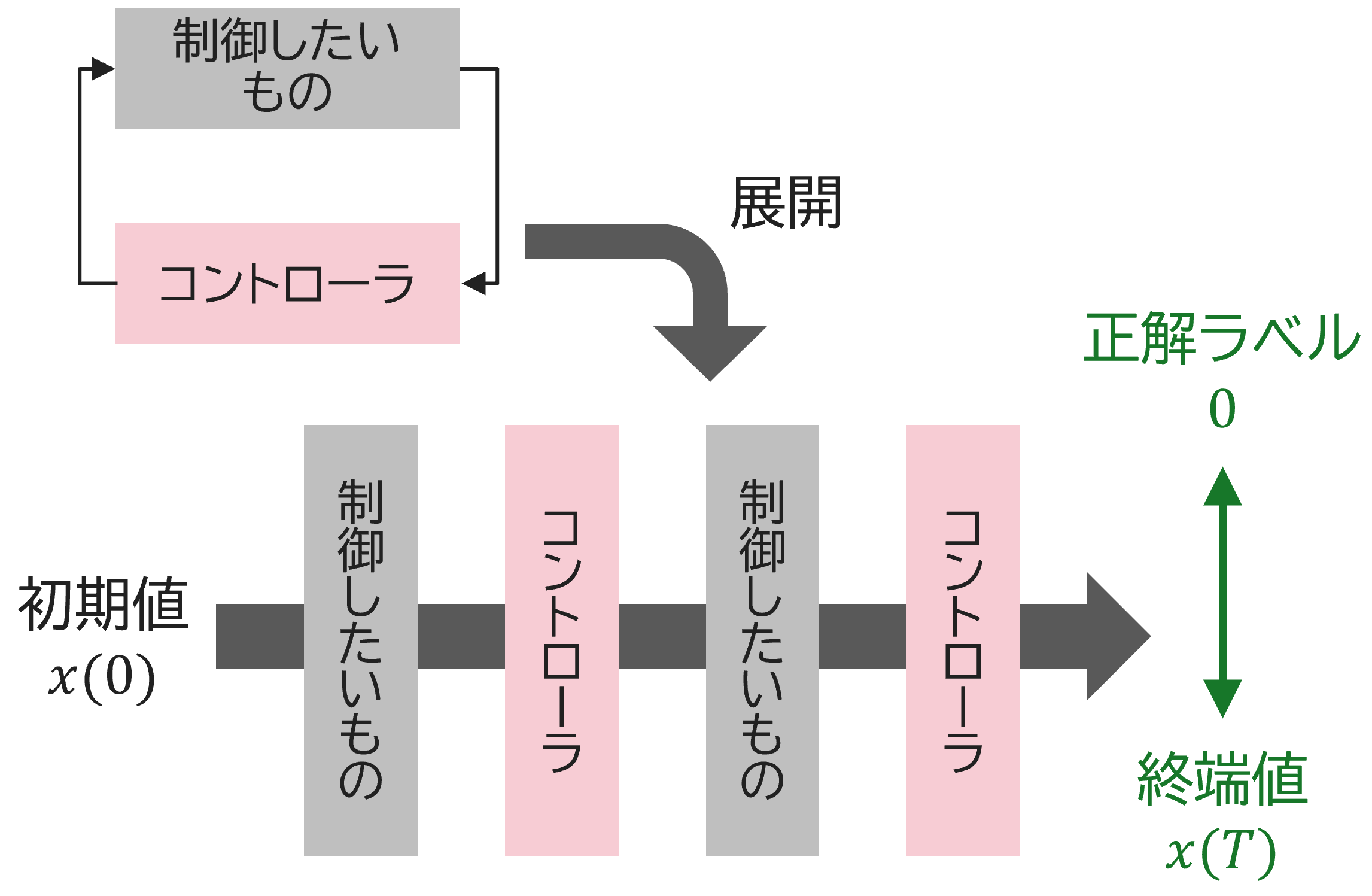
無線通信分野で近年活用されている深層展開の技術を用いたモデルベース制御系設計の研究を進めています.既存の理論では扱いが難しい非線形制御系の設計に対する有効性を確認しています.
以下に,デモンストレーションとして倒立振子の振り上げに提案手法を適用した様子を紹介します.様々な外乱に対する応答から誤差逆伝播を使ってオープンループ制御入力を学習します.学習の目標は,時刻t=5で振子を倒立した状態にさせることです.問題を難しくするために,振子の動きに対して適度な外乱が存在する状況を考えます.
学習前の様子です.制御入力を模索しています.
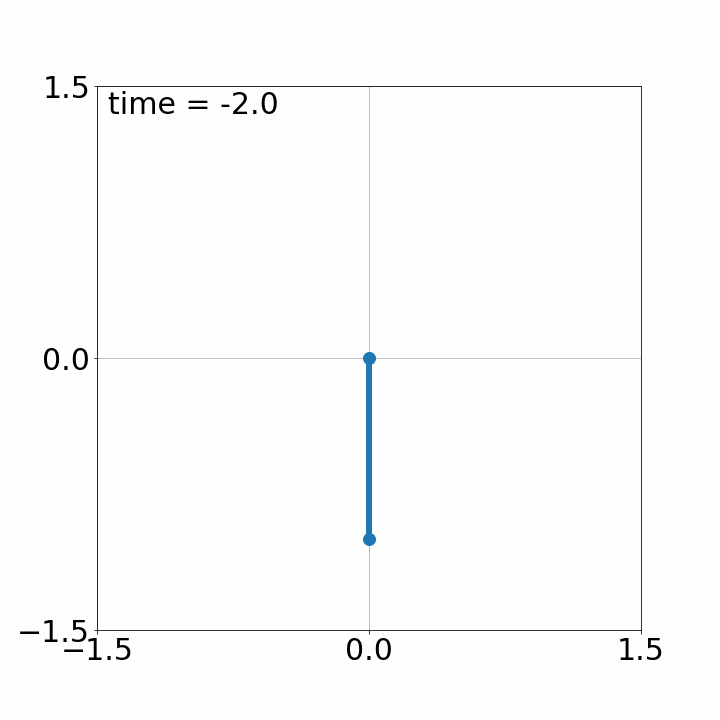
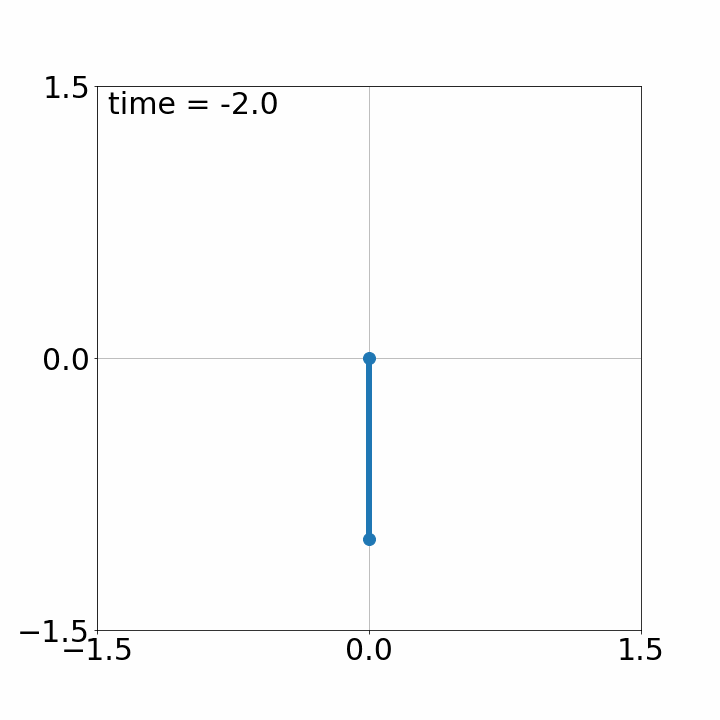
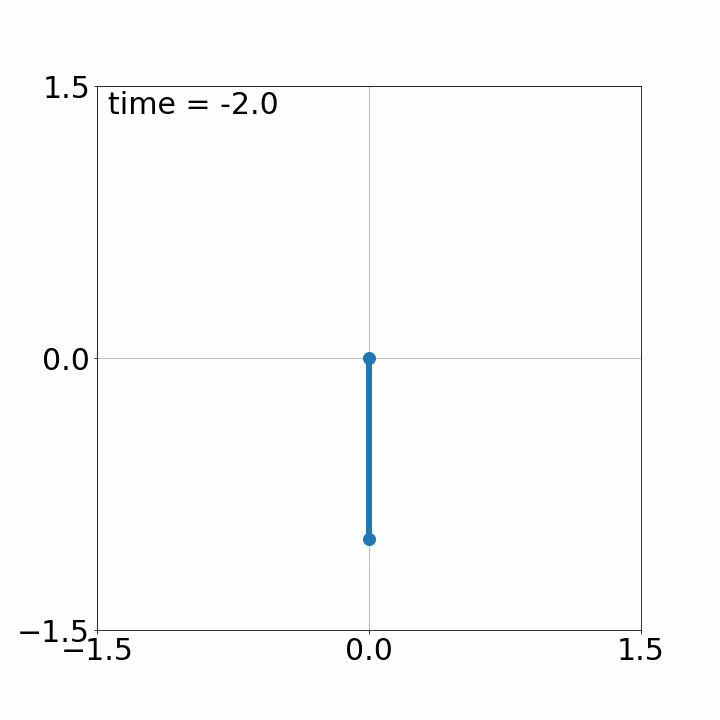
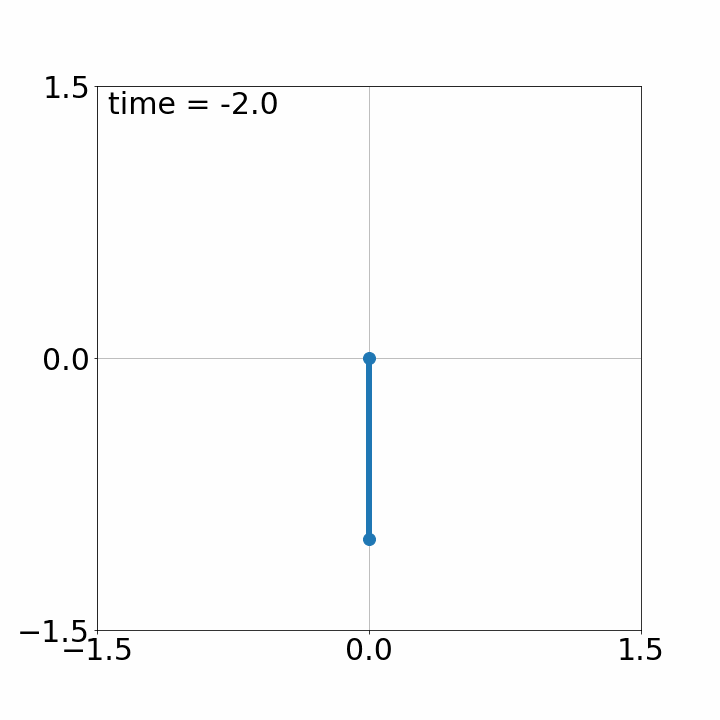
学習後の様子です.時刻t=5において振子を(だいたい)直立させることができています.
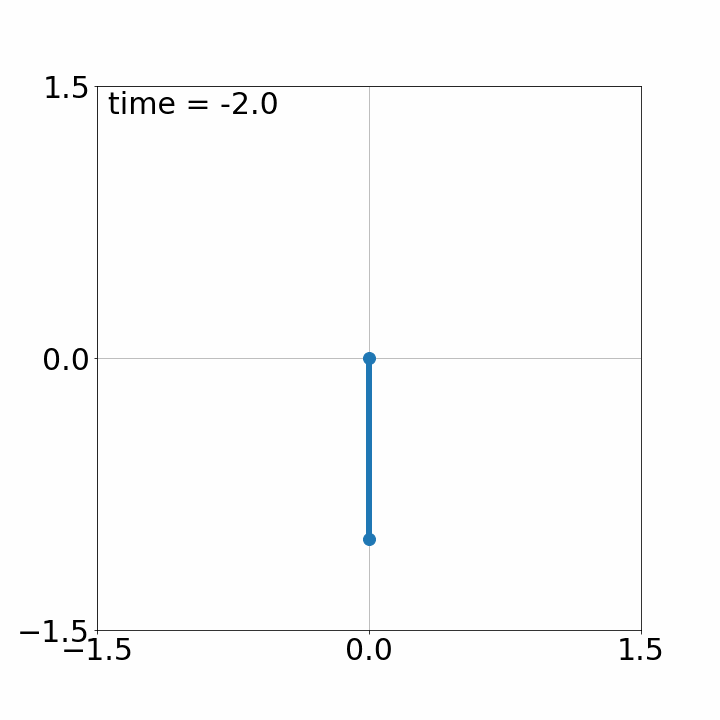
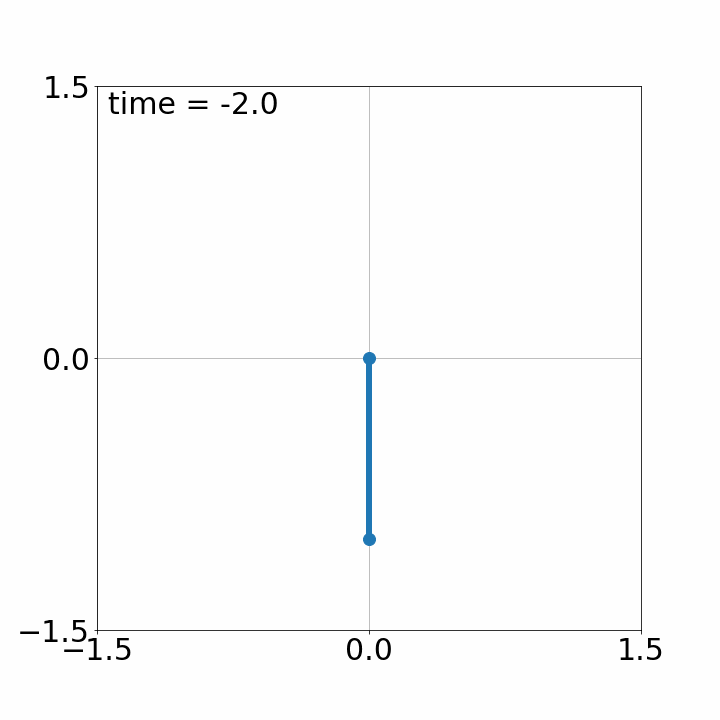
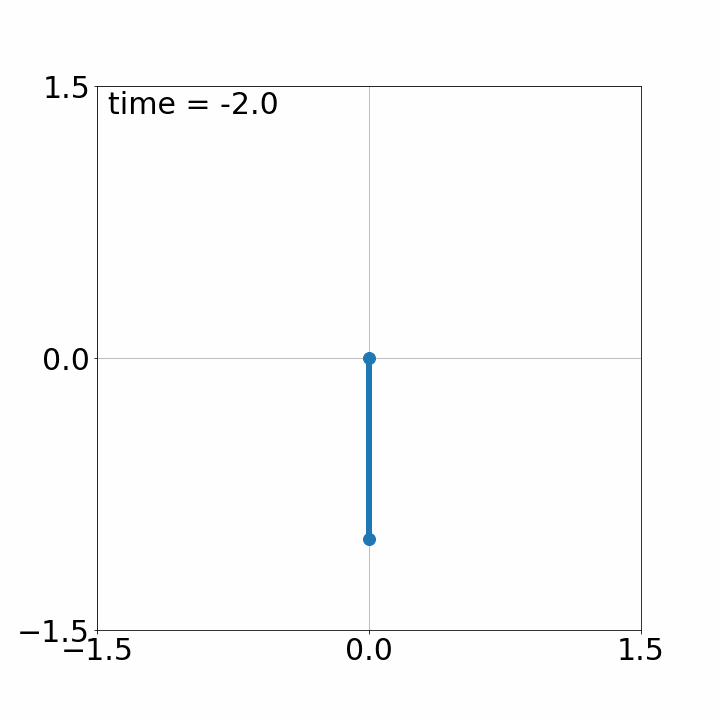
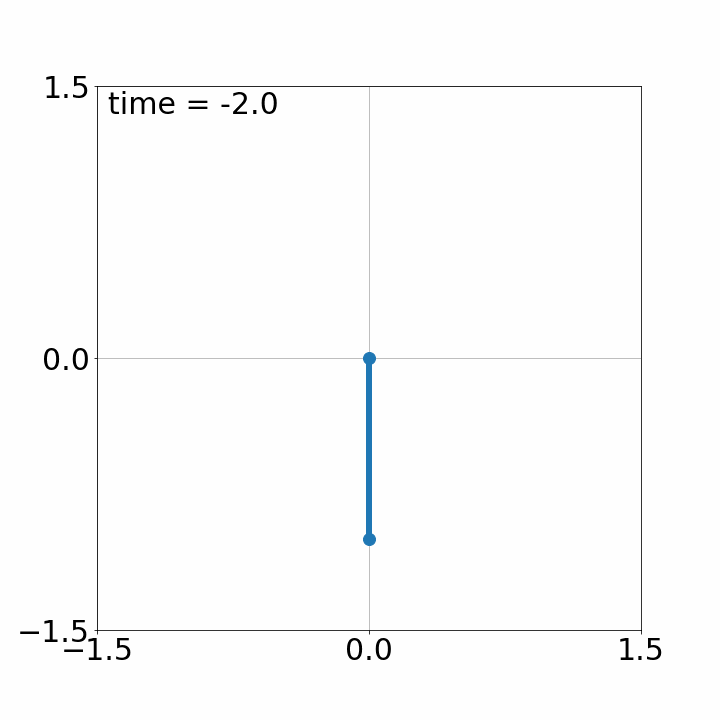
この手法の様々なシステムへの拡張,適用をしてみたい学生を募集しています.
スライド
参考文献
| [25] | J. J. R. Liu, M. Ogura, and J. Lam, “Learning-based stabilization of Markov jump linear systems,” Neurocomputing, vol. 584, p. 127618, 2024. [ DOI | http ] |
| [24] | 武内勇太朗, 岡野訓尚, and 小蔵正輝, “深層展開を用いたイベントトリガ制御系設計,” 第68回システム制御情報学会研究発表講演会(発表予定), pp. 22I-4, 2024. |
| [23] | J. Aizawa, M. Ogura, M. Shimono, and N. Wakamiya, “Manipulation of neuronal network firing patterns using temporal deep unfolding-based MPC,” in 2023 Asia-Pacific Signal and Information Processing Association Annual Summit and Conference, 2023, pp. 15-21. [ DOI | arXiv | http ] |
| [22] | 相澤純平, 小蔵正輝, 下野昌宣, and 若宮直紀, “時相深層展開を用いたMPCによるニューロンネットワークのモジュール発火制御,” 第66回自動制御連合講演会, pp. 412-413, 2023. [ DOI | http ] |
| [21] | “Enhancing Control System Design through Deep Unfolding: A Systematic Approach,” University of Hawaii at Manoa, 2023. [ http ] |
| [20] | 和田弘匡, 小蔵正輝, 岸田昌子, and 若宮直紀, “深層展開を用いた静的出力フィードバック安定化におけるハイパーパラメータの考察,” 計測自動制御学会論文集, vol. 59, no. 7, pp. 309-320, 2023. [ DOI | http ] |
| [19] | 相澤純平, 小蔵正輝, 岸田昌子, and 若宮直紀, “時相深層展開を用いたモデル予測制御の多重振り子系に対する有効性の検証,” システム制御情報学会論文誌, vol. 36, no. 4, pp. 91-98, 2023. [ DOI | http ] |
| [18] | J. Aizawa, M. Ogura, M. Shimono, and N. Wakamiya, “Temporal deep unfolding-based MPC for controlling firing patterns of neuronal network,” in 2023 RISP International Workshop on Nonlinear Circuits, Communications and Signal Processing, 2023. |
| [17] | 佐藤文哉, 小蔵正輝, 下野昌宣, and 若宮直紀, “ノイズを含む神経細胞モデルに対するNeural SDEを用いた発火制御,” 計測自動制御学会第10回制御部門マルチシンポジウム, pp. 3A8-3, 2023. |
| [16] | 和田弘匡, 小蔵正輝, 岸田昌子, and 若宮直紀, “制約下でのゲイン設計における深層展開のハイパーパラメータ選定について,” 計測自動制御学会第10回制御部門マルチシンポジウム, pp. 2M4-1, 2023. |
| [15] | 小蔵正輝 and 岸田昌子, “時相深層展開を用いた制御手法,” 2022年電子情報通信学会ソサイエティ大会, 2022. |
| [14] | M. Ogura, K. Kobayashi, and K. Sugimoto, “Static output feedback synthesis of time-delay linear systems via deep unfolding,” in 17th IFAC Workshop on Time Delay Systems, 2022, pp. 214-215. [ arXiv ] |
| [13] | “When deep unfolding meets control engineering,” 37th International Technical Conference on CircuitsSystems, Computers and Communications, 2022. [ http ] |
| [12] | 相澤純平, 小蔵正輝, 岸田昌子, and 若宮直紀, “時相深層展開を用いたモデル予測制御の多重振り子系に対する有効性の検証,” 第66回システム制御情報学会研究発表講演会, pp. 253-3, 2022. [ http ] |
| [11] | “深層展開を用いた汎用性の高いシステム制御技術の開発,” 電子情報通信学会コミュニケーションシステム研究会, 2022. [ http ] |
| [10] | “深層展開を用いたモデルベース制御系設計,” 第66回システム制御情報学会研究発表講演会, 2022. [ http ] |
| [9] | “深層展開と制御工学が出会うとき,” 電子情報通信学会信号処理研究会, 2022. [ http ] |
| [8] | 和田弘匡, 小蔵正輝, 岸田昌子, and 若宮直紀, “深層展開を用いた静的出力フィードバック安定化問題におけるハイパーパラメータの考察,” 第64回自動制御連合講演会, pp. 1F2-5, 2021. [ DOI | http ] |
| [7] | M. Kishida and M. Ogura, “Temporal deep unfolding for nonlinear maximum hands-off control,” in SICE Annual Conference 2021, 2021, pp. 1007-1010. [ arXiv ] |
| [6] | K. Kobayashi, M. Ogura, T. Kobayashi, and K. Sugimoto, “Deep unfolding-based output feedback control design for linear systems with input saturation,” in SICE International Symposium on Control Systems 2021, 2021, pp. 33-39. [ DOI | arXiv | http ] |
| [5] | 小林恒輝, 小蔵正輝, and 杉本謙二, “深層学習技術を用いたむだ時間システムの安定化の有効性評価,” 信学技報, vol. 120, no. 292, RCC2020-16, pp. 31-34, 2020. [ http ] |
| [4] | M. Kishida*, M. Ogura*, Y. Yoshida, and T. Wadayama, “Deep learning-based average consensus,” IEEE Access, vol. 8, pp. 142404-142412, 2020. (*equal contribution) [ DOI | arXiv | http ] |
| [3] | 森純平, 小蔵正輝, 小林泰介, and 杉本謙二, “確率的勾配降下法を用いたマルコフ過程のスパースな補間,” 第7回計測自動制御学会制御部門マルチシンポジウム, pp. 3I1-2, 2020. [ http ] |
| [2] | 小林恒輝, 小蔵正輝, 岸田昌子, 和田山正, and 杉本謙二, “Neural Ordinary Differential Equationを用いた静的出力フィードバック安定化の検討,” 信学技法, vol. 119, no. 395, RCC2019-73, pp. 19-22, 2020. [ http ] |
| [1] | 小林恒輝, 小蔵正輝, 岸田昌子, 和田山正, and 杉本謙二, “深層展開による出力フィードバック安定化の検討,” 信学技法, vol. 119, no. 270, RCC2019-65, pp. 59-62, 2019. [ http ] |
社会的ネットワークにおける感染症制御(科研費若手研究)

インフルエンザは毎年冬に流行します.学級閉鎖が頻繁に起こります.今年(2018年)の1月22日から28日の間だけでも,日本全体で約1万件の学年閉鎖・学級閉鎖がありました.我々の研究グループでは,学級閉鎖やそれを一般化した社会距離戦略の有効性を検証しています.特に,適応的に変化するネットワーク上の感染症のダイナミクスの理解およびその最適な制御手法の開発を目標としています.SISモデルやSIRモデル(下図)のような感染症伝播モデルを用いて研究を行います.
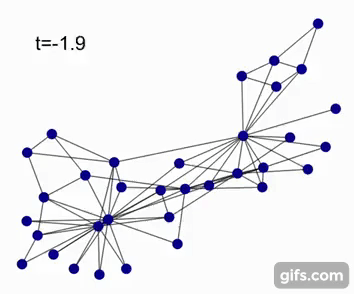
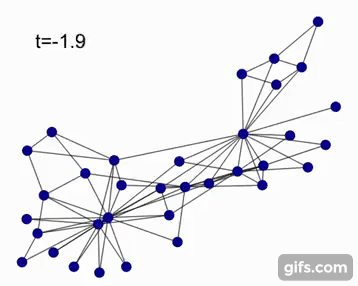
参考文献
| [12] | 小蔵正輝, “Moment closureを用いたネットワーク化SISモデルの解析,” 線形代数的グラフ理論とその応用, 2023. |
| [11] | R. Liu, M. Ogura, E. F. D. Reis, and N. Masuda, “Effects of concurrency on epidemic spreading in Markovian temporal networks,” European Journal of Applied Mathematics, 2023. [ DOI | arXiv | http ] |
| [10] | M. Ogura and C. Nowzari, “Special issue: modeling, analysis, and control of epidemics in networks,” Mathematical Biosciences and Engineering, vol. 20, no. 5, pp. 8446-8447, 2023. [ DOI ] |
| [9] | K. Hashimoto, Y. Onoue, M. Ogura, and T. Ushio, “Event-triggered control for mitigating SIS spreading processes,” Annual Reviews in Control, vol. 52, pp. 479-494, 2021. [ DOI | arXiv | http ] |
| [8] | 永原正章 and 小蔵正輝, “パンデミックとシステム・制御・ネットワーク理論,” 計測と制御, vol. 60, no. 9, pp. 641-646, 2021. [ DOI | http ] |
| [7] | 小蔵正輝, “中心性を使った感染症の制御,” 経済セミナー, no. 717, pp. 42-46, 2020. [ .html ] |
| [6] | N. Masuda, V. M. Preciado, and M. Ogura, “Analysis of the susceptible-infected-susceptible epidemic dynamics in networks via the non-backtracking matrix,” IMA Journal of Applied Mathematics, vol. 85, no. 2, pp. 214-230, 2020. [ arXiv | http ] |
| [5] | M. Ogura, W. Mei, and K. Sugimoto, “Upper-bounding dynamics on networked synergistic susceptible-infected-susceptible model,” in SICE Annual Conference 2019, 2019, pp. 1430-1431. |
| [4] | M. Ogura, V. M. Preciado, and N. Masuda, “Optimal containment of epidemics over temporal activity-driven networks,” SIAM Journal on Applied Mathematics, vol. 79, no. 3, pp. 986-1006, 2019. [ DOI | arXiv | http ] |
| [3] | M. Ogura and V. M. Preciado, “Second-order moment-closure for tighter epidemic thresholds,” Systems & Control Letters, vol. 113, pp. 59-64, 2018. [ DOI | arXiv | http ] |
| [2] | 小蔵正輝, “テンポラルネットワーク上の伝播過程,” 計測と制御, vol. 55, no. 11, pp. 942-947, 2016. [ DOI | http ] |
| [1] | M. Ogura and V. M. Preciado, “Stability of spreading processes over time-varying large-scale networks,” IEEE Transactions on Network Science and Engineering, vol. 3, no. 1, pp. 44-57, 2016. Runner-up of 2019 IEEE TNSE Best Paper Award. [ DOI | arXiv | http ] |
無線通信システム
TBD
参考文献
| [3] | 八木聖太, 小蔵正輝, 岸田昌子, 木村達明, and 林和則, “Geometric programによる送信電力制御アルゴリズムのロバスト安定化,” 電子情報通信学会論文誌B, vol. J103-B, no. 12, pp. 644-651, 2020. [ DOI | http ] |
| [2] | T. Kimura and M. Ogura, “Distributed collaborative 3D-deployment of UAV base stations for on-demand coverage,” in IEEE International Conference on Computer Communications 2020, 2020, pp. 1748-1757. Acceptance rate 19.8 percent. [ DOI | arXiv | http ] |
| [1] | Y. Abe, M. Ogura, H. Tsuji, A. Miura, and S. Adachi, “Resource and network management framework for a large-scale satellite communications system,” IEICE Transactions on Fundamentals of Electronics, Communications and Computer Sciences, vol. E103, no. 2, pp. 492-501, 2020. Telecom System Technology Student Award, Telecommunication Advancement Foundation. [ DOI | http ] |
非負システム(NII公募型共同研究)
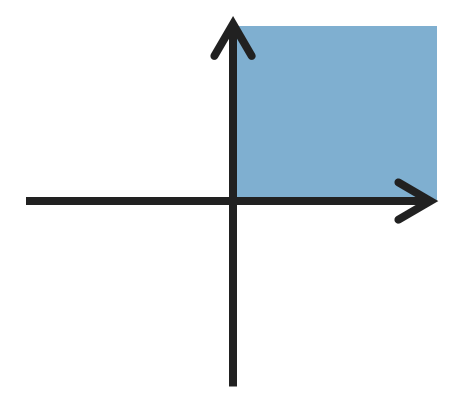
非負の値をもつ入力に対する応答が非負性を示すような動的システムは非負システムと呼ばれます.薬理学, 疫学,生物学,通信ネットワークなど幅広い応用をもちます.この研究では,従来用いられてきた線形計画ではなく,幾何計画と呼ばれる広いクラスの最適化手法を用いた非負システムの設計に取り組んでいます.
参考文献
| [13] | C. Zhao, B. Zhu, M. Ogura, and J. Lam, “Probability rate optimization of positive Markov jump linear systems via DC programming,” Asian Journal of Control (accepted for publication), 2024. [ DOI ] |
| [12] | 趙成岩 and 小蔵正輝, “DC計画を用いたカーシェアリングネットワークの最適化,” システム/制御/情報, vol. 67, no. 10, pp. 427-432, 2023. |
| [11] | C. Zhao, B. Zhu, M. Ogura, and J. Lam, “Parameterized synthesis of discrete-time positive linear systems: A geometric programming perspective,” IEEE Control Systems Letters, vol. 7, pp. 2551-2556, 2023. [ DOI | http ] |
| [10] | C. Zhao, X. Gong, Y. Ebihara, and M. Ogura, “Impulse-to-peak optimization of positive linear systems via DC programming,” in 22nd IFAC World Congress, 2023, pp. 5544-5549. [ DOI | http ] |
| [9] | X. Gong, M. Ogura, J. Shen, T. Huang, and Y. Cui, “Optimal epidemics policy seeking on networks-of-networks under malicious attacks by geometric programming,” IEEE Transactions on Systems, Man, and Cybernetics: Systems, vol. 53, no. 6, pp. 3845-3857, 2023. [ DOI | http ] |
| [8] | C. Zhao and M. Ogura, “Probability rate optimization of positive Markov jump linear systems via DC programming,” 第10回計測自動制御学会制御部門マルチシンポジウム, pp. 1A6-1, 2023. |
| [7] | B. Zhu, J. Lam, and M. Ogura, “Log-log convexity of an optimal control problem for positive linear systems,” Automatica, vol. 146, p. 110553, 2022. [ DOI | http ] |
| [6] | M. Ogura and C. Zhao, “DC programming for optimization of dynamic buffer networks,” 第8回計測自動制御学会制御部門マルチシンポジウム, pp. 1D1-2, 2021. [ http ] |
| [5] | 小蔵正輝, 岸田昌子, and 林參, “大規模非負システムの幾何計画による最適設計,” 計測と制御, vol. 60, no. 1, pp. 59-64, 2021. [ DOI | http ] |
| [4] | 八木聖太, 小蔵正輝, 岸田昌子, 木村達明, and 林和則, “Geometric programによる送信電力制御アルゴリズムのロバスト安定化,” 電子情報通信学会論文誌B, vol. J103-B, no. 12, pp. 644-651, 2020. [ DOI | http ] |
| [3] | M. Ogura, M. Kishida, and J. Lam, “Geometric programming for optimal positive linear systems,” IEEE Transactions on Automatic Control, vol. 65, no. 11, pp. 4648-4663, 2020. [ DOI | arXiv | http ] |
| [2] | C. Zhao, M. Ogura, and K. Sugimoto, “Stability optimization of positive semi-Markov jump linear systems via convex optimization,” SICE Journal of Control, Measurement, and System Integration, vol. 13, no. 5, pp. 233-239, 2020. [ DOI | arXiv | http ] |
| [1] | M. Ogura and C. F. Martin, “Stability analysis of positive semi-Markovian jump linear systems with state resets,” SIAM Journal on Control and Optimization, vol. 52, pp. 1809-1831, 2014. [ DOI | arXiv | http ] |
制御工学 × 設計工学(NII公募型共同研究)
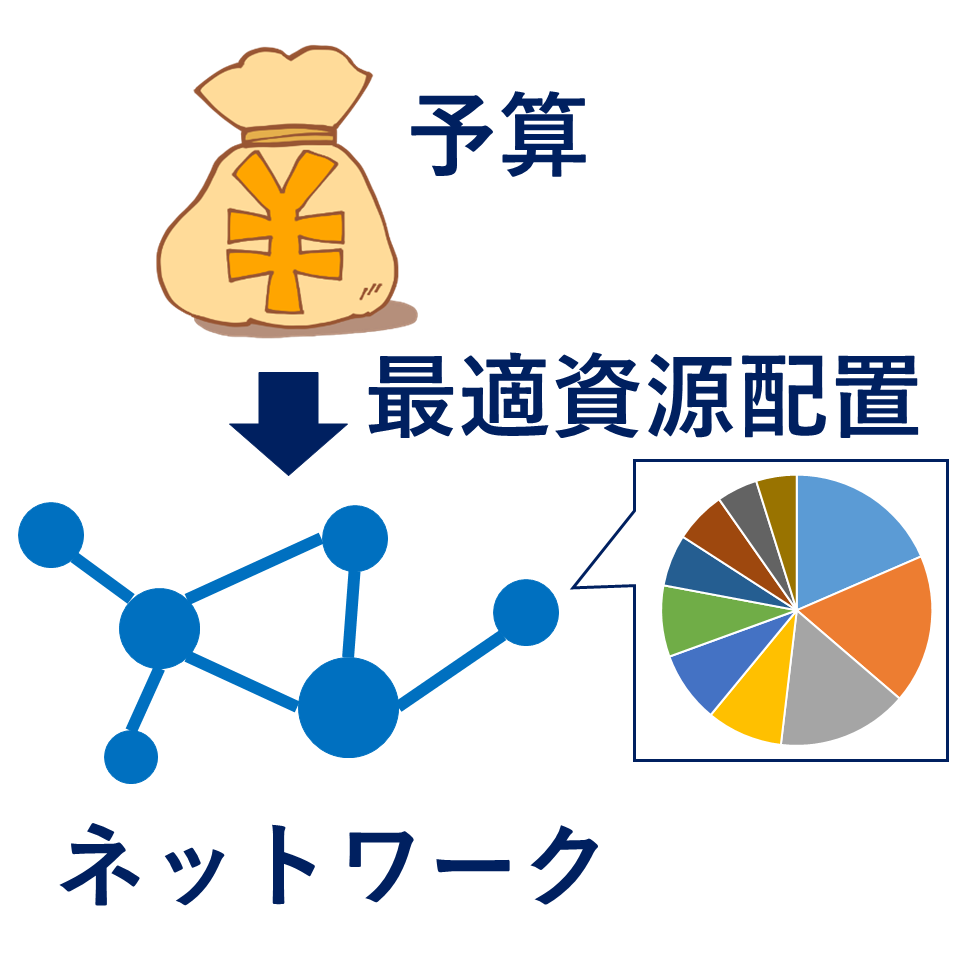
製品開発の過程を動的システムによりモデリングします.モデルに対して制御理論の方法論,とくに非負システム理論を適用することで,限られた人的・物的資源を製品開発のネットワークにおいて最適に配置できるようにします.
Slides
参考文献
| [3] | C. Zhao, M. Ogura, M. Kishida, and A. Yassine, “Optimal resource allocation for dynamic product development process via convex optimization,” Research in Engineering Design, vol. 32, no. 1, pp. 71-90, 2021. [ DOI | arXiv | http ] |
| [2] | M. Ogura, J. Harada, M. Kishida, and A. Yassine, “Resource optimization of product development projects with time-varying dependency structure,” Research in Engineering Design, vol. 30, no. 3, pp. 435-452, 2019. [ DOI | arXiv | http ] |
| [1] | 原田潤一, 小蔵正輝, 岸田昌子, and 杉本謙二, “設計プロジェクトにおける追加タスクの影響を最小化するためのロバスト最適化,” 日本機械学会第28回設計工学・システム部門講演会, 2018. [ DOI | http ] |
確率システム
TBD
スライド
TBD参考文献
| [7] | Q. Wang, Y. Bai, M. Ogura, and L. Peng, “Self-triggered energy-to-peak filtering for semi-Markov jump systems with incomplete semi-Markov kernel,” Submitted for publication, 2024. |
| [6] | M. Ogura and C. F. Martin, “Mean escape time of switched Riccati differential equations,” Journal of the Franklin Institute, vol. 360, no. 10, pp. 6827-6845, 2023. [ DOI | arXiv | http ] |
| [5] | M. Ogura and V. M. Preciado, “Asynchronous temporal interactions promote disparity in networks,” in 2023 International Symposium on Nonlinear Theory and its Applications, 2023, p. 25. [ DOI | http ] |
| [4] | M. Ogura and V. M. Preciado, “Stability of Markov regenerative switched linear systems,” Automatica, vol. 69, pp. 169-175, 2016. [ DOI | arXiv | http ] |
| [3] | M. Ogura and C. F. Martin, “Stability analysis of linear systems subject to regenerative switchings,” Systems & Control Letters, vol. 75, pp. 94-100, 2015. [ DOI | http ] |
| [2] | M. Ogura and C. F. Martin, “Stability analysis of positive semi-Markovian jump linear systems with state resets,” SIAM Journal on Control and Optimization, vol. 52, pp. 1809-1831, 2014. [ DOI | arXiv | http ] |
| [1] | M. Ogura and C. F. Martin, “Generalized joint spectral radius and stability of switching systems,” Linear Algebra and its Applications, vol. 439, no. 8, pp. 2222-2239, 2013. [ DOI | http ] |
